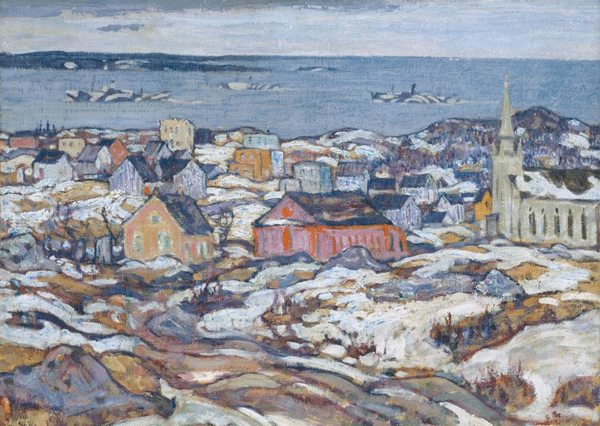This is Entrance to Halifax Harbour. It was painted by the Group of Seven’s A.Y. Jackson right at the very end of the First World War. He’d spent the last few years on the front lines in Europe: first as a soldier crawling through the trenches of Flanders, then as an artist with the Canadian War Records Office (a department created by the Canadian newspaper baron turned British cabinet minister, Lord Beaverbrook). But when the war finally ended, Jackson’s job wasn’t quite over: he was sent to Halifax to capture the scenes of Canadian soldiers returning home. Another member of the Group, the English-born Arthur Lismer, was already there; he was working for the War Records Office, too. Together, during the spring of 1919, they painted the warships as they came home. That’s when Jackson made the sketches for Entrance To Halifax Harbour, which he probably finished back home in Toronto — at the Studio Building in Rosedale.
In those early days, the Group of Seven weren’t famous yet (in fact, they weren’t even called the Group of Seven yet). And many Canadian critics hated them. They were too modern, too experimental. They were dismissed as “The Hot Mush School.” “A horrible bunch of junk.” “The figments of a drunkard’s dream.” “Daubing by immature children.” More than 30 years after Van Gogh painted Starry Night, Canada still wasn’t ready for Impressionism.
But in England, it was a whole different story. After the end of the war, an exhibition was held in London. Some of the Canadian paintings created for the War Records Office were put on display at the majestic Burlington House, a couple of blocks from Piccadilly Circus. Jackson wasn’t the only member of the Group of Seven with work hanging on the walls — Fred Varley (the other English-born member of the Group) had also been painting on the Western Front. But there were more pieces by Jackson than by anyone else. And the show was a big success. Thousands of people came to see the exhibit on the first day alone — including the Prime Minster of Canada, Robert Borden. Jackson’s paintings for the War Records Office would eventually end up in some of the most important collections in Canada, including the National Gallery, the War Museum and the Art Gallery of Ontario.
Entrance To Halifax Harbour wasn’t part of that exhibit. But just a few years later, the painting finally got its chance. In 1924, the English government organized a massive display of industry, engineering and artwork from all over the British Empire. The British Empire Exhibition was a very big deal: the biggest and most popular exhibition that had ever been held anywhere. Back in Canada, the job of picking the Canadian art submissions sparked a major battle between the old guard of conventional, established artists and the modernist up-and-comers like the Group of Seven. In the end, the modernists won the right to be included. And Entrance To Halifax Harbour was sent to London.
The reviews by Canadian critics were harsh. The Toronto Daily Star compared Jackson’s work to “a spilt can of paint.” But the English critics loved it. The Morning Post called the Group of Seven “the foundation of what may become one of the greatest schools of landscape painting.” One piece of Canadian art was even sold during the British Empire Exhibition — and it was Jackson’s. Entrance To Halifax Harbour was bought by the Tate Gallery. It’s still part of their collection today.
And despite the poor Canadian reviews, the show in London helped to establish the Group of Seven’s reputation back home. Now that the British took the Group seriously, Canadian collectors started taking them seriously, too. The Group even used the bad press to promote their upcoming shows: they printed posters with the angry Canadian reviews side by side with the glowing English ones.
Even today, the Group of Seven are lauded by some British critics. A major exhibition of their work was mounted by a London gallery just a couple of years ago. According to the gallery’s director, “[The Group of Seven] produced some of the most vibrant and beautiful landscapes of the twentieth century.” He calls their friend Tom Thomson “Canada’s very own Van Gogh.”
A version of this post originally appeared on the The Toronto Dreams Project Historical Ephemera Blog. You can find more sources, links and related stories there.





